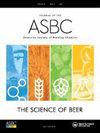关于啤酒花(Humulus lupulus L.)的自由穷尽文献综述
IF 1.8
4区 农林科学
Q4 BIOTECHNOLOGY & APPLIED MICROBIOLOGY
Journal of the American Society of Brewing Chemists
Pub Date : 2023-07-12
DOI:10.1080/03610470.2023.2232267
引用次数: 0
摘要
摘要本文介绍了啤酒花的化学背景,在酿造过程中添加啤酒花以提供香气和苦味的方法,并讨论了干跳的最佳条件,以最大限度地提取香气,同时最小化苦味等问题。精油的提取速度比酿酒商通常认为的要快得多,只需2-3天就能达到最大值,而且不会受到较低温度的负面影响。本文讨论了包装干啤酒花啤酒中不可发酵碳水化合物被啤酒花糊化酶降解的潜在参考问题,以及干啤酒花或酸啤酒中IBU尺度将感知苦味与异α-酸水平相关联的限制。虽然啤酒花品种的苦味酸和精油含量和成分各不相同,但由于酿酒酵母对香叶醇的生物转化和香叶酯和多功能硫醇的酶促释放,生啤酒花的香气可能与最终产品的“啤酒花香气”不太相关。添加时间、温度、酒精浓度、搅拌、酵母菌株,甚至发酵容器尺寸都是影响提取、转化、烟雾形成或挥发性物质损失的因素,这些挥发性物质是通过二氧化碳的洗涤作用和对酵母细胞的吸附而产生的。最后,介绍了啤酒花的最新产品,从新的啤酒花产品到具有增强硫醇裂解能力的转基因酵母,再到啤酒花的潜在植物替代品。在论文的“背景部分”提供了一个链接,将读者带到论文全文和详细参考文献列表。本文章由计算机程序翻译,如有差异,请以英文原文为准。
A Free Exhaustive Literature Review on Hops (Humulus lupulus L.)
Abstract This article presents a background on hop chemistry, methods of addition during the brewing process to provide aroma and bitterness, and it discusses the optimal conditions for dry-hopping to maximize aroma extraction while minimizing bitterness and other issues. Essential oil extraction occurs much faster than what is commonly believed by brewers, reaching a maximum within only 2–3 days, and it is not negatively impacted by lower temperatures. This review discusses the potential problems of refermentation that may occur in packaged dry-hopped beers from the degradation of unfermentable carbohydrates by hop dextrinases, and the limits of the IBU scale in dry-hopped or sour beers to correlate perceived bitterness with iso-α-acids levels. While hop varieties can vary in bitter acids and essential oil levels and composition, the aroma of raw hops may not correlate well with the ‘hoppy aroma’ of the final product due to biotransformation of geraniol and enzymatic release of geranyl esters and polyfunctional thiols by brewing yeast. Timing of addition, temperature, alcohol levels, agitation, yeast strain, and even fermentation vessel dimensions are all factors that can influence the extraction, transformation, haze formation or loss of volatiles by the scrubbing effect of carbon dioxide and adsorption to yeast cells. Finally, the newest products available for brewers are presented, from new hop products to genetically-modified yeasts with enhanced thiol cleavage ability, to potential plant alternatives to hops. A link is provided in the ‘Background Section’ of the paper that takes the reader to the full paper and list of detailed references.
求助全文
通过发布文献求助,成功后即可免费获取论文全文。
去求助
来源期刊

Journal of the American Society of Brewing Chemists
工程技术-生物工程与应用微生物
CiteScore
4.00
自引率
20.00%
发文量
41
审稿时长
3 months
期刊介绍:
The Journal of the American Society of Brewing Chemists publishes scientific papers, review articles, and technical reports pertaining to the chemistry, microbiology, and technology of brewing and distilling, as well as the analytical techniques used in the malting, brewing, and distilling industries.
 求助内容:
求助内容: 应助结果提醒方式:
应助结果提醒方式:


